Site menu:
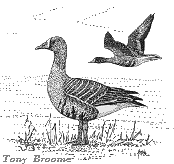
March 2012 Newsletter
Highlights - March 2011 to February 2012.
URGENT - Neston Reed Bed Voluntary Wardens!
February Bird News.
Forthcoming Events.
Latest Newsletter.
Highlights - March 2011 to February 2012
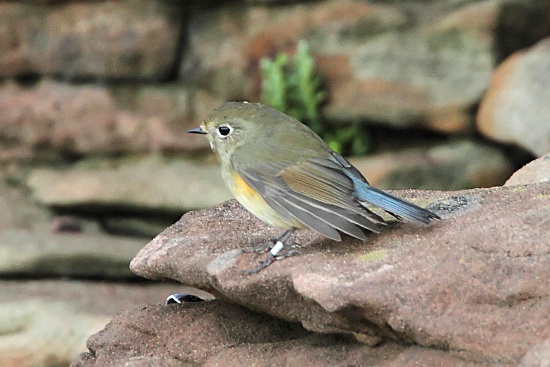
This website is 14 years old this month and as usual I do the
highlights for the past 12 months.
I said last March that the previous 12 months had been the best since the website started. This last year has also been excellent, it didn't quite reach the highs of 2010/11 but wasn't far off!
Rarities
We had at least 30 species which were County or BBRC rarities around the Dee Estuary and I mention some of the more exciting ones here.
As usual Hilbre seemed to have the pick with a Blyth's Reed Warbler in June and a Red-flanked Bluetail in October, the former is the second for Cheshire and Wirral and the latter a first. A Black Kite seen flying across the estuary from Hilbre in August was another good record.
Hoylake shore had a couple of nice waders, a Broad-billed Sandpiper in May and a White-rumped Sandpiper in August. Remarkably we had a Red-rumped Swallow at Leasowe for the fourth year running.
Gales in both September and October brought in some great birds including a Balearic Shearwater, a couple of Sooty Shearwaters, Sabine's Gulls, a 'Blue' Fulmar, Long-tailed and Pomarine skuas and Grey Phalaropes.
A Great White Egret showed a couple of times on both sides of the estuary during the summer but it wasn't until September 24th that we got a really good view of it at Parkgate. Remarkably it then stayed all winter and is still there as I write. Over that period it was joined by another bird on several occasions and in January a total of three were present. Two adult Common Cranes were a great sight on Heswall Marsh in November where they spent a few hours. It was a great winter for geese with the icing on the cake the arrival of two, then a total of three, Bean Geese at Burton in January.
The Best of the Rest
It had been one of the best ever waxwing winters across the country but we had some of our best views of them in April with three spending several days in Deeside followed by 19 in Irby showing very well and 49 briefly at West Kirby.
It was an excellent spring migration with loads of Grasshopper Warblers, e.g. 10 at both Leasowe Lighthouse and Red Rocks, good numbers of Wheatears (max 80 at Leasowe Lighthouse), max daily count of 150 Willow Warblers on Hilbre and 16 Whinchats at Point of Ayr. But the star birds for me were the wagtails. First were the White Wagtails which migrate from continental Europe to Iceland, the passage peaked on April 9th when they carpeted the shore from West Kirby to Hoylake feeding on sand flies, a conservative estimate was of 400 birds but the total for the day could easily have been double that. Next were Yellow Wagtails which peaked in early May with a maximum of 58 in the horse paddocks by Leasowe Lighthouse making for a spectacular display of several shades of yellow. May also brought in exceptional numbers of spring passage waders including 15,000 Dunlin and 1,000 Ringed Plover at Hoylake.
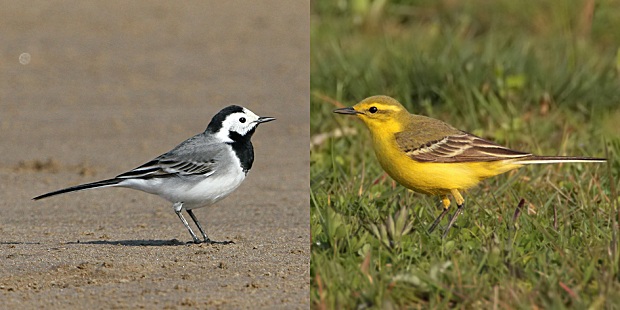
November was good for both Short-eared Owls (two counts of 20) and Snow Buntings (20 sightings) but there were much fewer of the former through the winter and the latter have been largely absent since then. The winter was a fantastic one for geese. There was a record number of Pale-bellied Brent Geese with a maximum of 262 at West Kirby on a high tide (my count). We had the best winter for European White-fronted Geese for at least 50 years with numbers in double figures for over three months, reaching a maximum of 63 in February. We also had, like the previous winter, up to 2,000 Pink-footed Geese - a huge number by Dee Estuary standards! They were more easily seen this winter either in fields around Burton or on the marshes quite close in to Parkgate.
My year finished as it began, with spring migrants. A Sand Martin and White Wagtail at the end of February are the earliest ever recorded during the 14 years this website has been going.
The other highlights were the opening of Burton Mere Wetlands RSPB in September and the digging of two new flashes on Parkgate Marsh through the summer - both have been a great success.
Voluntary Wardens Needed to Protect Neston Reed Bed
 Once
again the RSPB are organising voluntary wardening at Neston Reed Bed,
the scheme will begin near the end of March and run through until the
end of May. Wardening will take place each evening in order to protect
this important habitat from disturbance. I know in the past this scheme
has attracted birders who have realised what a good opportunity this
location is for some serious birdwatching with the possibility of
seeing migrating Ospreys and Marsh Harriers, large numbers of Little
Egrets flying in to roost, Bearded Tits, Hen Harriers, Short-eared Owls
and the numerous birds which breed in the reed bed. If you are
interested please contact Geoff Robinson (Geoffrey.Robinson@rspb.org.uk),
telephone 0151 336 7681.
Once
again the RSPB are organising voluntary wardening at Neston Reed Bed,
the scheme will begin near the end of March and run through until the
end of May. Wardening will take place each evening in order to protect
this important habitat from disturbance. I know in the past this scheme
has attracted birders who have realised what a good opportunity this
location is for some serious birdwatching with the possibility of
seeing migrating Ospreys and Marsh Harriers, large numbers of Little
Egrets flying in to roost, Bearded Tits, Hen Harriers, Short-eared Owls
and the numerous birds which breed in the reed bed. If you are
interested please contact Geoff Robinson (Geoffrey.Robinson@rspb.org.uk),
telephone 0151 336 7681.
Top of Page
February Bird News
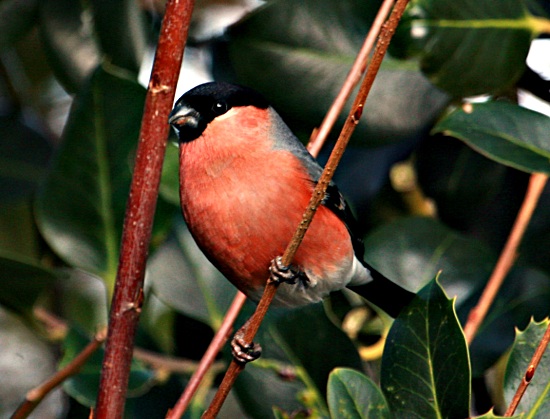
The White-fronted Geese, featured in last month's newsletter, increased to 63 showing well in a field close to Pudington village when I saw them. Also showing well were a thousand or so Pink-footed Geese which took to feeding at Parkgate Marsh with many only a hundred yards or so from the prom. Also at Parkgate was a Great White Egret and Spoonbill.
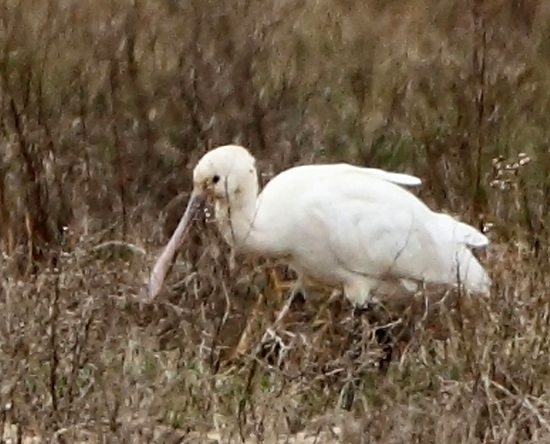
Highlights from Hilbre mostly involved wildfowl with an Eider on the 9th, 600 Common Scoter on the 26th and 219 Brent Geese on the 29th. 600 Common Scoter were off Hoylake on the 29th and on the same day 280 Great Crested Grebes and 7 Scaup on a flat calm sea at Meols. A Glaucous Gull was off Meols on the 14th but gull numbers generally never reached the massive numbers seen last year.
Seven Short-eared Owls were on Burton Marsh on the 5th but the sea was nowhere near high enough to flush them from the marsh at Parkgate during the spring tides. Two Lapland Buntings caused some controversy at Connah's Quay. I'm led to believe that all the photos supposedly of these birds actually show either Reed Buntings or Skylarks. Nevertheless they were seen and identified as Lapland Buntings by an RSPB Warden who is also an experienced local birder, not somebody likely to get it wrong!
I said at the start of this article that we had spring like weather at the end of the month, and that weather was suitably marked by a sighting of a very early Sand Martin on the 28th at Leasowe Lighthouse, the earliest recorded during the 14 year history of this website.

Richard Smith.
What to expect in March
| Species | 2011 | Location (2011) | 2010 | 2009 |
|---|---|---|---|---|
| White Wagtail | 11th March | West Kirby | 12th March | 4th March |
| Sand Martin | 12th March | Hilbre | 18th March | 15th March |
| Wheatear | 13th March | West Kirby, Meols, Inner Marsh Farm and Red Rocks. | 10th March | 14th March |
| Swallow | 20th March | Hilbre | 18th March | 16th March |
| Willow Warbler | 16th March | Leasowe Lighthouse | 19th March | 31st March |
| House Martin | 25th March | Inner Marsh Farm and Thurstaston | 30th March | 30th March |
| Whitethroat | 8th April | Thurstaston | 7th April | 11th April |
| Swift | 17th April | Burton | 19th April | 8th April |
| Cuckoo | 20th April | Burton | 10th May | 26th April |
High spring tides can be expected (see below) and hopefully the wind will be blowing and bring it over the marsh giving the usual spectacular views of Short-eared owls, Hen Harriers, Water Rails, waders and wildfowl.
Forthcoming Events
March Highest Spring Tides (Liverpool)
Also
see Tides
page.
9th March, 11.36hrs (GMT), 9.9m.
10th March, 12.16hrs (GMT), 10.0m.
11th March, 12.57hrs (GMT), 9.9m.
Forthcoming Events
Organised by the Wirral
Ranger Service , Flintshire Countryside Service and/or the
RSPB:
All these events and walks have bird interest, even those not
advertised specifically for birdwatching. No need to book for these
events unless specified - please check below.
Also see 2012 Events Diary.
Friday 9th March, 10am start, RSPB High
Tide Birdwatch at Parkgate.
High tide at 11.36am, 9.9m. The
marshes of Parkgate and the surrounding areas hold masses of small
mammals and bird life. Will this year’s tides flood the
entire
marsh and cause the wildlife spectacle hundreds of people travel miles
to see?
RSPB
Staff and volunteers will be on hand to help identify the birds and
explain what is happening and why. Meet at Old Baths car park
overlooking the marsh. Ring 0151 353 8478 or 0151 336 7681 for more
info.
Saturday 10th March, start 9.30am, High tide birdwatch at King’s Gap, Hoylake.
You
will discover why Wirral’s foreshore is an internationally protected
site when you join the Dee Estuary Voluntary Wardens, Coastal Rangers
and the RSPB on this winter birdwatch at Hoylake. Organised as part of
Wirral’s Year of Coast and Countryside. High tide at 11.57am,
10.0m
No need to book. Ring
0151 648 4371 for
more info.
Saturday 10th March, 10am start, RSPB High Tide Birdwatch at Parkgate.
High tide at 12.16pm, 10.0m. See 9th March event for info.
Sunday 11th March, 10am start, RSPB High Tide Birdwatch at Parkgate.
High tide at 12.57pm, 9.9m. See 9th March event for info.
Sunday 18th March, 4pm start, RSPB Raptor
Watch at Parkgate.
Pop along at any point until sunset for great views of the rare hen
harrier. Merlin, Peregrine and Short-eared owls are also a
regular
sightings here. Meet at Old Baths car park overlooking the marsh. Ring
0151 353 8478 or 0151 336 7681 for more info.
Saturday 24th March, 10am to 1pm, RSPB
Woodland Walk.
The
RSPB will lead a guided walk which will be a gentle four mile round
trip starting at Ness Gardens taking in Burton Woods and the amazing
new facilities at RSPB Burton Mere Wetlands. Cost of £10 (£8.00 to
Friends of Ness Gardens) includes a lunch of soup, roll and drink back
at Ness Gardens at the end of the walk. Booking Essential -
please ring 0151 353 0123.
Sunday 25th March, 1:00pm -
3:00pm, A Walk on the Wild Side - Thurstaston
Common.
Walk with the Ranger and discover the wildlife of this unique habitat.
Meet at Thurstaston Hill car park off Telegraph Road.
Please wear suitable footwear and clothing.
No booking required. Sorry no dogs.
For further enquiries telephone: 0151 677 7594
Saturday 7th April, 10am start, RSPB High Tide Birdwatch at Parkgate.
High tide at 12.11pm, 9.9m. The
marshes of Parkgate and the surrounding areas hold masses of small
mammals and bird life. Will this year’s tides flood the
entire
marsh and cause the wildlife spectacle hundreds of people travel miles
to see?
RSPB
Staff and volunteers will be on hand to help identify the birds and
explain what is happening and why. Meet at Old Baths car park
overlooking the marsh. Ring 0151 353 8478 or 0151 336 7681 for more
info.
Sunday 8th April, 10am start, RSPB High Tide Birdwatch at Parkgate.
High tide at 12.54pm, 10.0m.
Monday 9th April, 10am start, RSPB High Tide Birdwatch at Parkgate.
High tide at 1.39pm, 9.9m.
Saturday 14th April, Hilbre
Low Tide Birdwatch, 8:00am start to 1:30pm latest.
Join the Rangers, the RSPB and staff from the Hilbre Bird Observatory
on this low tide birdwatching event on Hilbre Island.
We hope to catch up with some early spring migrants, learn about the
work of the Hilbre Bird Observatory, the bird ringing processes and the
fantastic migration journeys that visiting birds undertake. Booking
essential. Phone (0151) 648 4371.
|